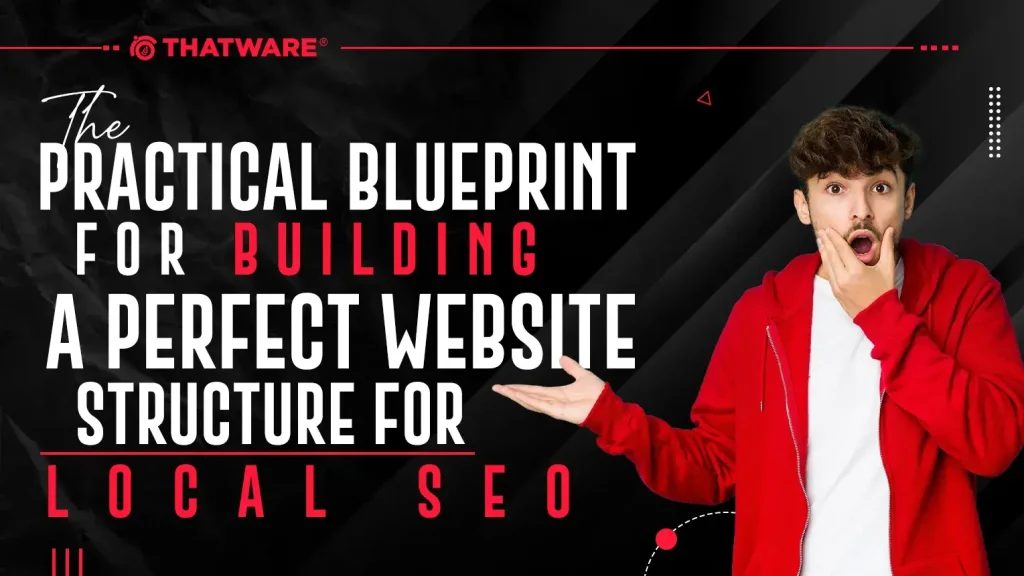SUPERCHARGE YOUR ONLINE VISIBILITY! CONTACT US AND LET’S ACHIEVE EXCELLENCE TOGETHER!
Most local businesses pour endless time and money into content marketing — blog posts, SEO tweaks, flashy website designs — and yet, they never break into the top 3 spots on Google Maps. Why? Because they are following generic SEO advice that’s outdated, ineffective, and often completely misaligned with how local SEO actually works.

If you’re serious about dominating local search — even in ultra-competitive cities like downtown Chicago, Houston, or Miami — you need a practical and proven blueprint tailored specifically for local SEO success.
This guide isn’t about writing “more blogs.” It’s about building a Google-approved local website structure that ranks, converts, and dominates. Let’s dive into it.
Step 1: Optimize Your Homepage as the Local Authority Hub
Think of your homepage as your local headquarters. It’s not just a welcome mat — it’s the core foundation for your Google Business Profile (GBP) success. Every local SEO effort you make should radiate from your homepage.
Here’s exactly what to do:
- Make your homepage the landing page for your Google Business Profile (GBP). When people click your GBP listing, they should land on a page designed specifically to convert local traffic — your homepage.
- Title Tag Strategy: Format it as:
“[Primary Service] in [City] | 24/7 Local Experts”
Example: “Plumbing Services in Chicago | 24/7 Local Experts”
- H1 and Opening Paragraph: Don’t get cute. Hit your primary keyword + city immediately.
Example:
“Trusted Plumbing Services in Chicago” — then within the first 50 words, reinforce what you offer and where.
- Mention Services, Service Areas, and Your Unique Selling Proposition (USP): Your homepage should act as a “mini-site map.” Briefly mention your main services, areas you serve, and why you’re the local authority (e.g., 24/7 availability, free estimates, 20+ years of service).
- Add Local Schema Markup: Implement a LocalBusiness schema using JSON-LD to communicate your Name, Address, and Phone Number (NAP) directly to Google. NAP consistency is non-negotiable — your homepage, citations, GBP, and socials must all match exactly.
Step 2: Maximize GBP Categories (The 1% Strategy)
Most businesses select one GBP category and call it a day. This is a massive mistake.
Google allows up to 10 categories — and the smart businesses are using every slot.
How to do it:
- Spy on Competitors: Use tools like GMBSpy or manually review top competitors to uncover the categories they use.
- Choose All Relevant Categories: Add them to your GBP — even if they seem slightly secondary.
- Reflect Categories on Your Homepage: For each major category, add an H2 heading and write 300-400 words about it. This builds topical relevance and local authority.
Example:
- H2: Emergency Plumbing Services in Chicago
- 300 words about your emergency services.
Doing this connects your website directly to your GBP categories, reinforcing your authority in Google’s eyes.
Step 3: Build Secondary Category Pages
This step separates amateur websites from professionally structured local SEO machines.
For each GBP secondary category, build a dedicated landing page.
The Blueprint:
- URL Format:
/city/secondary-category
Example: /chicago/emergency-plumbing
- Each Page Should Include:
- A clear H1 with service + city.
- Subtopics: Cover different aspects of the service (e.g., for plumbing, talk about tankless vs traditional water heaters).
- Hyperlocal Focus: Mention neighborhoods or ZIP codes you serve.
- FAQ Schema: Use structured data to answer common questions — boosting your chance of appearing in “People Also Ask” results.
Why this works:
By building out these pages, you’re sending clear, detailed signals to Google about the full scope of your expertise — not just your main service.
Step 4: Create 30+ Service-Specific Pages
This is where almost every local business fails — and where you absolutely crush it.
Instead of having generic “Services” pages that list everything, you must create one page per service.
How to do it:
- List 30-50 Services: Pull them directly from your GBP and competitor listings.
- Create a Page for Each Service: Follow this template:
- Title Tag:
“[Service] in [City] | Fast & Reliable”
- Content Structure (800–1500 words):
- H1: Service + City
- Introduction and Benefits
- Your Unique Process
- Price Ranges (even if it’s a ballpark)
- Areas Served
- Strong Call-to-Action (e.g., “Call Now for Immediate Help”)
Example:
/Chicago/toilet-repair — a full page specifically optimized for “Toilet Repair in Chicago.”
Step 5: Strategic Internal Linking Structure
Your internal links should mirror a hub-and-spoke model, enhancing topical and geographic relevance.
Here’s the system:
- Homepage → Main Category Pages:
Your homepage should link out to your major service category pages. - Category Pages → Service Pages:
Each category page should link to its related service pages. - Service Pages → Parent Category Pages:
Include contextual links that guide users (and Google) up the hierarchy. - Use Exact Match Anchor Text Sparingly:
1–2 times per page is ideal. Over-optimizing anchor text can actually hurt rankings. - Add a Service Areas Section:
On every page, include a section that links to hyperlocal city or neighborhood pages using branded or semi-branded anchor text.
Advanced & Unique SEO Techniques to Secure #1 Ranking
Now that you’ve built a rock-solid local SEO foundation with a perfectly structured website, it’s time to take things to the next level.
These are not your typical “blog and hope for the best” tactics.
These are battle-tested, advanced strategies that the top 1% of local businesses use to dominate the Map Pack — while the competition is still stuck wondering why they’re invisible.
Let’s get into the nitty-gritty.
1. Geo-Grid Tracking with Local Falcon: See What Google Really Sees
One of the biggest mistakes local businesses make is assuming their Google Business Profile (GBP) rankings are the same across an entire city.
They’re not.
Google’s local algorithm is hyper-sensitive to user proximity.
That means you could be ranking #1 on Main Street, but completely invisible just five blocks over.
Solution?
Use Local Falcon — a geo-grid tracking tool that visually maps your rankings across dozens (even hundreds) of points on a grid.
How it works:
- Scan your GBP across a defined area — ZIP code, neighborhood, or city section.
- Visualize your weak spots where you’re dropping out of the top 3 (or not showing at all).
- Target those micro-areas with new service pages, location pages, backlinks, or additional citations.
Pro tip: Run these scans monthly to stay ahead of competitors, adjusting your strategy as the map changes.
Why it matters:
You’re no longer optimizing blindly. You’re sniping weak points, boosting your dominance block-by-block.
2. Use Programmatic SEO to Build Hyperlocal Pages (Without Losing Quality)
Covering an entire metro area manually is a nightmare — and it’s why most businesses give up after a few city pages.
Enter Programmatic SEO.
Programmatic SEO allows you to create hundreds of hyperlocal landing pages quickly by combining templates, AI assistance, and manual optimization.
The Blueprint:
- Template URL structure: /service-area/neighborhood/service
- Example: /toilet-repair-houston-heights
- Populate content: Use templates that automatically insert:
- Neighborhood names
- Service types
- Local testimonials
- Service area maps
Then manually optimize each page’s intro paragraph, FAQs, and CTAs to avoid thin, duplicate content penalties.
Pro tip: Even if 80% of the page is template-based, that custom 20% (especially in the first 200 words) makes all the difference for rankings.
Why it matters:
You become the obvious choice in every neighborhood — not just the city center.
3. Add Hidden Schema for NLP Signals (Speak Google’s Language)
You already know about basic schema markup like LocalBusiness and Organization.
But to dominate the Map Pack, you need to go deeper — giving Google richer semantic signals through hidden JSON-LD schema.
Advanced Schema to Add:
json
CopyEdit
{
“@context”: “https://schema.org”,
“@type”: “LocalBusiness”,
“name”: “Your Business Name”,
“areaServed”: “Houston Heights”,
“offers”: {
“@type”: “Offer”,
“itemOffered”: “Emergency Plumbing Services”
},
“aggregateRating”: {
“@type”: “AggregateRating”,
“ratingValue”: “4.9”,
“reviewCount”: “234”
}
}
Include properties like:
- areaServed (specific neighborhoods)
- offers (specific services)
- aggregateRating (show off your 5-star reviews)
Pro tip: Use a schema validator like Google’s Rich Results Test to verify it’s implemented correctly.
Why it matters:
Google’s NLP algorithms better understand your expertise and location relevance, making you more likely to appear in featured snippets and Map Packs.
4. Optimize for Click-Through with Local Emojis (Stand Out in SERPs)
Sometimes winning isn’t just about being first — it’s about grabbing attention.
Adding local and service-related emojis to your title tags and meta descriptions helps you stand out in crowded SERPs, resulting in a higher click-through rate (CTR).
Examples:
- Title Tag: 📍 Toilet Repair in Chicago | 24/7 Experts
- Meta Description: Need a 🚿 water heater installed fast? Call our Houston plumbers today! 🛠️
Pro tip: Don’t overdo it — one or two emojis max per snippet keeps it professional.
Why it matters:
Higher CTRs send positive engagement signals to Google — boosting your organic rankings over time.
5. Dynamic Content Insertion (Make Every Visitor Feel Like the Star)
Want your landing pages to feel like they were built specifically for each visitor?
Use dynamic content insertion.
Dynamic insertion tools detect the user’s location (based on IP address or browser settings) and customize parts of your content on the fly.
Dynamic Content Examples:
- Dynamic Heading:
“Need Emergency Plumbing in [User’s Neighborhood]?” - Dynamic CTA:
“Call Our [User’s City] Team for Fast Help!”
Pro tip: Pair dynamic insertion with geo-structured URLs for the ultimate hyperlocal experience.
Why it matters:
It dramatically increases relevance, trust, and conversion rates — especially for mobile users looking for urgent services nearby.
6. Geo-Networked Backlinks (The Local Link Secret Sauce)
Backlinks are still the #1 off-page ranking factor — but local backlinks are 10x more powerful for Map Pack dominance.
Instead of chasing generic guest posts, focus on geo-networked backlink building.
How to Get Local Backlinks:
- Sponsor local events: Charity runs, food festivals, school fundraisers
- Collaborate with local bloggers and micro-influencers
- Get listed in local chambers of commerce, city directories, or business alliances
- Partner with schools, libraries, or local nonprofits
Pro tip: Request backlinks with natural, branded anchor text like:
“trusted plumber in Houston” or “award-winning HVAC services in Chicago.”
Why it matters:
Google sees local backlinks as a trust signal — confirming you’re a real, relevant business in the community.
7. Build Location Silos (Structure Your Site Like a Local Authority)
If you serve multiple areas, don’t just scatter random service pages.
Build a location silo structure to organize your hyperlocal authority.
How to Structure It:
- /locations/ (hub page listing all cities/neighborhoods)
- /locations/houston-heights/
- /locations/rice-village/
- /locations/montrose/
- Each location page should include:
- Unique local content (history, notable landmarks)
- Services offered in that area
- Real customer reviews from residents
- Driving directions with embedded Google Maps
- Photos from jobs done in that area (geo-tagged)
Pro tip: Interlink location pages with related services and category pages for maximum internal SEO juice.
Why it matters:
Google rewards well-structured, clearly siloed sites by giving them broader and stronger coverage in local search — even in highly competitive metros.
Final Words: Build for Google Maps, Not Just Google Search
Too many local businesses are chasing rankings for blog posts — and missing the real prize:
Ranking their Google Business Profile at the top of Google Maps.
When you structure your website using this proven blueprint, you’re telling Google three vital things:
- Who you are (Local authority in your field)
- What you offer (Clear services and service areas)
- Where you serve (Specific cities, ZIP codes, neighborhoods)
Once Google understands these signals, your GBP skyrockets — bringing in calls, leads, and walk-in customers like never before.
Remember:
The businesses that dominate local search don’t just have great services — they have a structure that tells Google exactly how to rank them.If you implement this blueprint, you won’t just compete in your local market — you’ll own it.

Thatware | Founder & CEO
Tuhin is recognized across the globe for his vision to revolutionize digital transformation industry with the help of cutting-edge technology. He won bronze for India at the Stevie Awards USA as well as winning the India Business Awards, India Technology Award, Top 100 influential tech leaders from Analytics Insights, Clutch Global Front runner in digital marketing, founder of the fastest growing company in Asia by The CEO Magazine and is a TEDx speaker and BrightonSEO speaker.

